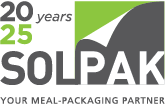Managing temperatures in the food service industry is not just about compliance – it’s the key to success. Mastering thermal preservation ensures the safety of your customers while strengthening and growing your business.
Get ready to dive into a topic that, while technical, is fundamental for any institutional food service professional committed to excellence and performance.
Why is temperature control essential?
Food safety largely depends on keeping food at safe temperatures. Food that is not stored at the right temperature falls into what is known as the “danger zone,” which ranges from 4°C (39°F) to 60°C (140°F). In this temperature range, harmful bacteria such as Salmonella, E. coli, and Listeria can multiply rapidly, doubling every 20 minutes.
When food stays too long in this danger zone, the risk of foodborne illnesses increases, which can have serious health consequences for consumers and negatively impact a company’s reputation. For institutions like hospitals or prisons, where residents may have weakened immune systems, keeping food at the right temperature is a matter of quality and a moral obligation.
Hot holding and cold holding: Understanding the principles
Hot holding: This process involves keeping food at a high temperature, generally above 60°C (140°F), until it is served. Dishes are often prepared in advance and stored in specialized equipment, such as warmers or heat-sealed trays, that prevent heat loss. The main advantage of hot holding is that it reduces the risk of microbial contamination by keeping food above the danger zone.
Cold holding: In contrast, cold holding involves storing food below 4°C (39°F), thus preventing bacterial growth. This process is particularly useful for food that needs to be stored for extended periods before consumption, such as salads, desserts, or pre-prepared buffet items. Heat-sealed trays can also play a crucial role here by providing a thermal barrier that helps maintain cold temperatures and prevent contamination.
Food quality: Taste and texture at stake
The impact of temperature on quality
In addition to safety, food quality is directly affected by its storage temperature. Food stored at an incorrect temperature can suffer taste, texture, and appearance degradation. For example, a hot dish that cools down before consumption can become dry or rubbery, while a cold dish that warms up can deteriorate in texture, becoming soggy or watery.
Hot holding preserves the flavour and consistency of hot dishes, preventing drying or overcooking. Similarly, cold holding keeps food fresh and crisp, maintaining its appeal and nutritional value.
Reducing food waste
Food waste is a significant issue in the food industry, both for environmental and financial reasons. Whether held at the wrong temperature or exposed to thermal fluctuations, poorly stored food can quickly become unsafe to eat. This leads to increased food waste, resource loss, and reduced profits.
Businesses can significantly reduce food waste by ensuring proper thermal preservation through heat-sealed trays and appropriate equipment. Not only does this protect the environment by limiting waste, but it also maximizes profits by reducing financial losses.
Solutions for optimal temperature control
Thermal barriers: The role of heat-sealed trays
Heat-sealed trays play a vital role as a thermal barrier, keeping food at the desired temperature for extended periods. Their design allows for retaining heat or cold while protecting the food from external contamination. They are especially useful in environments where meals must be transported over long distances or stored for several hours before consumption.
These trays also simplify logistics by ensuring food remains at the correct temperature without additional equipment like refrigerators or mobile warmers. This is particularly advantageous for caterers, meal delivery, and institutional food services.
Equipment and preservation technologies
In addition to heat-sealed trays, investing in high-quality thermal preservation equipment, such as warmers, heated holding cabinets, or efficient refrigerators, is essential. Modern technologies also offer real-time temperature monitoring systems to ensure food is consistently kept at the ideal temperature.
Precise temperature control of food is a fundamental aspect of food service management. Whether you choose hot or cold holding, the goal remains to ensure safety, quality, and efficiency in your operations while minimizing waste. Heat-sealed trays and other thermal preservation solutions are crucial in this process, providing an effective barrier against thermal and microbiological risks.
By investing in suitable packaging solutions and high-performance equipment, you can protect your customers’ health and improve your business’s profitability and sustainability. Contact us today to learn more about our packaging solutions designed to optimize thermal preservation. Our experts are ready to help you choose the best options to meet your company’s needs.

